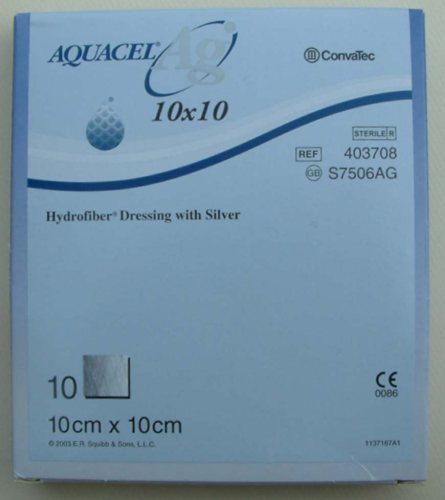
| Product Name: | Aquacel AG |
| Classification Name: | Sodium Carboxymethylcellulose Primary Wound Dressing containing silver |
| Manufacturer: | ConvaTec |
Aquacel Ag is a primary wound dressing made from sodium carboxymethylcellulose (NaCMC) containing 1.2% silver in an ionic form.

The NaCMC is produced as a textile fibre and presented in the form of a fleece held together by a needle bonding process, and is available both as a `ribbon' for packing cavities and as a flat non-woven pad for application to larger open wounds.
The dressing absorbs and interacts with wound exudate to form a soft, hydrophilic, gas-permeable gel that traps bacteria and conforms to the contours of the wound whilst providing a micro-environment that is believed to facilitate healing.
In the presence of sodium ions from wound exudate, the silver ions are released from the NaCMC to exert a sustained antimicrobial effect against a wide range of organisms including methicillin-resistant Staphylococcus aureus (MRSA), and vancomycin-resistant Enterococcus (VRE), thus preventing colonization of the dressing and providing an antimicrobial barrier to protect the wound.
Sheets of Aquacel Ag may be applied to exuding lesions including leg ulcers, superficial pressure ulcers, partial-thickness burns, and most other granulating wounds, but for deeper cavity wounds and sinuses the ribbon packing is generally preferred. The dressing is easy to remove without causing pain or trauma, and leaves minimal residue on the surface of the wound.
Although there are no known contra-indications to the use of Aquacel Ag, the dressing will be of little value if applied to wounds that are very dry, or covered with hard black necrotic tissue.
An Aquacel Ag dressing, chosen to be slightly larger than the area of the wound, is placed in intimate contact with the wound base and covered with a sterile secondary dressing held in place with surgical tape or a bandage as appropriate.
On lightly exuding wounds it is possible to apply the dressing then gently moisten the area directly over the wound with sterile water or saline. The nature of the secondary dressing will be governed by the condition of the wound. If large quantities of exudate are anticipated, a simple absorbent dressing pad may be required; but as the wound heals and less exudate is produced, a thinner pad bearing a plastic film of low adherence may help to conserve moisture and prevent the wound drying out too quickly.
Deeper cavity wounds or sinuses may be dressed with Aquacel Ag Ribbon, which should be placed gently in position but not packed in too tightly. It is recommended that only about 80% of the cavity should be filled with the dressing to accommodate swelling, and that a short length of ribbon be left to overhang the wound margin to facilitate removal.
Because of the needling process used in its construction, the dressing has significant wet strength, which means that it can be easily removed from a wound in one piece, a process that may be facilitated by irrigation with water or sterile normal saline. This may be accomplished without causing either damage to the wound or pain to the patient.
The interval between dressing changes will depend entirely upon the state of the wound and the nature of the secondary dressing. Aquacel Ag applied to heavily exuding or sloughy wounds may need replacing daily initially, but as healing progresses and the amount of exudate decreases, the interval between changes may be extended to up to 14 days in burns. At this stage a change to an alternative dressing - such as a film product, should be considered to conserve moisture.
Wounds that show signs of clinical infection may be dressed with Aquacel Ag but the dressing should be changed daily and the use of systemic antibiotic therapy considered. The dressing should not be used on patients with a known sensitivity to this dressing or one of its components.
The dressings are presented individually packed in peel pouches, sterilised by gamma radation.
Aquacel is available in a range of sizes as follows;
5cm x 5cm
10cm x 10cm
15cm x 15cm
20cm x 30cm
2g x 45cm ribbon
1.Armstrong SH, Ruckley CV. Use of a fibrous dressing in exuding leg ulcers. Journal of Wound Care 1997;6(7):322-4.
2.Foster L, Moore P, Clark S. A comparison of hydrofibre and alginate dressings on open acute surgical wounds. Journal of Wound Care 2000;9(9):442-445.
3.Bowler PG, Jones SA, Davies BJ, Coyle E. Infection control properties of some wound dressings. Journal of Wound Care 1999;8(10):499-502.
4.Thomas S, McCubbin P. An in vitro analysis of the antimicrobial properties of 10 silver-containing dressings. J Wound Care 2003;12(8):305-8.
Further information on obtaining ConvaTec products is available on
the ConvaTec web
site.
| Revision Author | Dr S. Thomas |
| Revision No | 1.4 |
| Revision date | 2006/01/23 |
This datacard has been prepared from data provided by the manufacturer and/or from published literature.